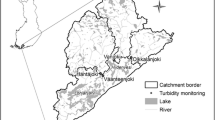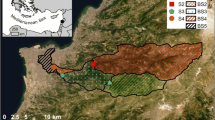Abstract
Better management of water quality in streams, rivers and lakes requires precise and accurate estimates of different contaminant loads. We assessed four sampling frequencies (2 days, weekly, fortnightly and monthly) and five load calculation methods (global mean (GM), rating curve (RC), ratio estimator (RE), flow-stratified (FS) and flow-weighted (FW)) to quantify loads of nitrate-nitrogen (NO3−–N), soluble inorganic nitrogen (SIN), total nitrogen (TN), dissolved reactive phosphorus (DRP), total phosphorus (TP) and total suspended solids (TSS), in the Manawatu River, New Zealand. The estimated annual river loads were compared to the reference ‘true’ loads, calculated using daily measurements of flow and water quality from May 2010 to April 2011, to quantify bias (i.e. accuracy) and root mean square error ‘RMSE’ (i.e. accuracy and precision). The GM method resulted into relatively higher RMSE values and a consistent negative bias (i.e. underestimation) in estimates of annual river loads across all sampling frequencies. The RC method resulted in the lowest RMSE for TN, TP and TSS at monthly sampling frequency. Yet, RC highly overestimated the loads for parameters that showed dilution effect such as NO3−-N and SIN. The FW and RE methods gave similar results, and there was no essential improvement in using RE over FW. In general, FW and RE performed better than FS in terms of bias, but FS performed slightly better than FW and RE in terms of RMSE for most of the water quality parameters (DRP, TP, TN and TSS) using a monthly sampling frequency. We found no significant decrease in RMSE values for estimates of NO3−N, SIN, TN and DRP loads when the sampling frequency was increased from monthly to fortnightly. The bias and RMSE values in estimates of TP and TSS loads (estimated by FW, RE and FS), however, showed a significant decrease in the case of weekly or 2-day sampling. This suggests potential for a higher sampling frequency during flow peaks for more precise and accurate estimates of annual river loads for TP and TSS, in the study river and other similar conditions.








Similar content being viewed by others
References
Aulenbach, B. T., & Hooper, R. P. (2006). The composite method: an improved method for stream-water solute load estimation. Hydrological Processes, 20(14), 3029–3047.
Baker, D. B. (1982). Fluvial transport and processing of sediments and nutrients in large agricultural basins. Athens, Georgia, U.S. http://www.dtic.mil/get-tr-doc/pdf?AD=ADA111894
Beale, E. M. L. (1962). Some uses of computers in operational research. Industrielle Organisation, 31(1), 27–28.
Birgand, F., Appelboom, T. W., Chescheir, G. M., & Skaggs, R. W. (2011). Estimating nitrogen, phosphorus, and carbon fluxes in forested and mixed-use watersheds of the lower coastal plain of north Carolina: uncertainties associated with infrequent sampling. Transactions of the ASABE, 54(6), 2099–2110.
Birgand, F., Faucheux, C., Gruau, G., Augeard, B., Moatar, F., & Bordenave, P. (2010). Uncertainties in assessing annual nitrate loads and concentration indicators. Part 1: impact of sampling frequency and load estimation algorithms. Transactions of the ASABE, 53, 1–10.
Bobbi, C. (1999). Water quality of the pipers river. No. WRA 99/19. Tasmania: Hobart.
Cassidy, R., & Jordan, P. (2011). Limitations of instantaneous water quality sampling in surface-water catchments: comparison with near-continuous phosphorus time-series data. Journal of Hydrology, 405(1–2, 182), –193.
Chorus, E., & Bartram, J. (1999). Toxic cyanobacteria in water: a guide to their public health consequences, monitoring and management. http://citeseerx.ist.psu.edu/viewdoc/summary?doi=10.1.1.169.7298. Accessed 30 May 2013
Cohn, T. A. (1995). Recent advances in statistical methods for the estimation of sediment and nutrient transport in rivers. Reviews of Geophysics, 33, 1117–1123.
Coynel, A., Schäfer, J., Hurtrez, J. E., Dumas, J., Etcheber, H., & Blanc, G. (2004). Sampling frequency and accuracy of SPM flux estimates in two contrasted drainage basins. Science of the Total Environment, 330(1–3), 233–247. https://doi.org/10.1016/j.scitotenv.2004.04.003.
European Community. (2000). Directive 2000/60/EC of the European Parliament and of the Council of 23 October 2000 establishing a framework for community action in the field of water policy. Official Journal of the European Parliament (Vol. L327). Brussels, Belgium. doi:https://doi.org/10.1039/ap9842100196
Gassman, P., Reyes, M., Green, C., & Arnold, J. (2007). The soil and water assessment tool: historical development, applications, and future research directions. Transactions of the ASABE, 50(4), 1211–1250.
Guo, Y., Markus, M., & Demissie, M. (2002). Uncertainty of nitrate-N load computations for agricultural watersheds. Water Resources Research, 38(10), 3–1–3–12.
Huang, J.-C., Lee, T.-Y., Kao, S.-J., Hsu, S.-C., Lin, H.-J., & Peng, T.-R. (2012). Land use effect and hydrological control on nitrate yield in subtropical mountainous watersheds. Hydrology and Earth System Sciences, 16(3), 699–714.
Jiang, Y., Frankenberger, J. R., Bowling, L. C., & Sun, Z. (2014). Quantification of uncertainty in estimated nitrate-N loads in agricultural watersheds. Journal of Hydrology, 519, 106–116.
Johnes, P. J. (2007). Uncertainties in annual riverine phosphorus load estimation: Impact of load estimation methodology, sampling frequency, baseflow index and catchment population density. Journal of Hydrology, 332(1–2), 241–258.
Ledein, E., Ausseil, O., & Roygard, J. (2007). Identifying point source and non-point source contributions to nutrient loadings in water ways in three catchments in the Manawatu-Wanganui Region: technical report to support policy development. Palmerston North, New Zealand. https://www.horizons.govt.nz/HRC/media/Media/One Plan Documents/point-source-non-point-source.pdf?ext. = .pdf
Littlewood, I. (1992). Estimating contaminant loads in rivers: a review. Wallingford, U.K. http://nora.nerc.ac.uk/7353/1/IH_117.pdf. Accessed 20 March 2014
Littlewood, I., Watts, C., & Custance, J. (1998). Systematic application of United Kingdom river flow and quality databases for estimating annual river mass loads (1975–1994). Science of the Total Environment, 210/2011, 21–40.
Mason, C. F. (2002). Biology of freshwater pollution (4th ed.). Harlow, England: Prentice-Hall, Pearson Education Limited.
Ministry for the Environment. (2014). National Policy Statement for Fresh-water Management. Wellington, New Zealand. http://www.mfe.govt.nz/publications/fresh-water/national-policy-statement-freshwater-management-2014
Moatar, F., & Meybeck, M. (2005). Compared performances of different algorithms for estimating annual nutrient loads discharged by the eutrophic River Loire. Hydrological Processes, 19(2), 429–444.
Moatar, F., Meybeck, M., Raymond, S., Birgand, F., & Curie, F. (2013). River flux uncertainties predicted by hydrological variability and riverine material behaviour. Hydrological Processes, 27(25), 3535–3546. https://doi.org/10.1002/hyp.9464.
National Research Council. (1992). Restoration of aquatic ecosystems: science, technology, and public policy. Washington, DC: The National Academies Press. https://doi.org/10.17226/1807.
Norton, N., & Kelly, D. (2010). Current nutrient loads and options for nutrient load limits for a case study catchment: Hurunui catchment. Christchurch, New Zealand. http://previous.ecan.govt.nz/publications/Reports/current-nutrient-loads-options-nutrient-load-limits-case-study-hurunui-catchment.pdf. Accessed 19 March 2014
Phillips, J. M., Webb, B. W., Walling, D. E., & Leeks, G. J. L. (1999). Estimating the suspended sediment loads of rivers in the LOIS study area using infrequent samples. Hydrological Processes, 13(7), 1035–1050.
Pimentel, D., Berger, B., Filiberto, D., Newton, M., Wolfe, B., Karabinakis, E., et al. (2004). Water resources: agricultural and environmental issues. BioScience, 54(10), 909–918.
Quilbé, R., Rousseau, A. N., Duchemin, M., Poulin, A., Gangbazo, G., & Villeneuve, J.-P. (2006). Selecting a calculation method to estimate sediment and nutrient loads in streams: application to the Beaurivage River (Québec, Canada). Journal of Hydrology, 326(1–4), 295–310.
R Core Team. (2015). R: a language and environment for statistical computing. Vienna, Austria.: R Foundation for Statistical Computing. http://www.r-project.org/
Richards, R. (1998). Estimation of pollutant loads in rivers and streams: A guidance document for NPS programs. Denver: Region VIII.
Richards, R., & Holloway, J. (1987). Monte Carlo studies of sampling strategies for estimating tributary loads. Water Resources Research, 23(10), 1939–1948.
Roygard, J., & Clark, M. (2012). Supplementary statement by Jon Roygard and Maree Clark on nutrient load scenarios and methodology. Palmerston North, New Zealand. https://www.horizons.govt.nz/HRC/media/Media/One Plan/New-Approach-to-evidence-Jon-and-Maree-20,120,224.pdf?ext. = .pdf
Roygard, J., McArthur, K., & Clark, M. (2012). Diffuse contributions dominate over point sources of soluble nutrients in two sub-catchments of the Manawatu River, New Zealand. New Zealand Journal of Marine and Freshwater Research, 46(2), 219–241.
Sanford, R. F., Pierson, C. T., & Crovelli, R. A. (1993). An objective replacement method for censored geochemical data. Mathematical Geology, 25(1), 59–80.
Schilling, K., & Zhang, Y.-K. (2004). Baseflow contribution to nitrate-nitrogen export from a large, agricultural watershed, USA. Journal of Hydrology, 295(1–4), 305–316.
Shih, G., Abtew, W., & Obeysekera, J. (1994). Accuracy of nutrient runoff load calculations using time-composite sampling. Transactions of the ASAE, 37(2), 419–429.
Snelder, T. H., McDowell, R. W., & Fraser, C. E. (2017). Estimation of catchment nutrient loads in New Zealand using monthly water quality monitoring data. Journal of the American Water Resources Association, 53(1), 158–178. https://doi.org/10.1111/1752-1688.12492.
Stephens, T. (2015). Hauraki rivers water quality indicators: status and trends.
Ullrich, A., & Volk, M. (2010). Influence of different nitrate-N monitoring strategies on load estimation as a base for model calibration and evaluation. Environmental monitoring and assessment, 171(1–4), 513–527.
USEPA. (1999). Protocol for developing nutrient TMDLs. Protocol for Developing Nutrient TMDLs. Washington D.C., U.S. doi:EPA 841-R-00-002
Vitousek, P. M., Aber, J. D., Howarth, R. W., Likens, G. E., Matson, P. A., Schindler, D. W., et al. (1997). Human alteration of the global nitrogen cycle: sources and consequences. Ecological Applications, 7(3), 737–750.
Woodward, S. (2015). Land-to-water transfer of nutrients: what knowledge can be gained by combined analysis of river water quality and flow records? (Vol. 1058–7-R1). Hamilton, New Zealand. http://www.waikatoregion.govt.nz/TR201524/
Zamyadi, A., Gallichand, J., & Duchemin, M. (2007). Comparison of methods for estimating sediment and nitrogen loads from a small agricultural watershed. Canadian Biosystems Engineering, 49(1), 27–36.
Zeileis, A., Grothendieck, G., Ryan, J. A., & Andrews, F. (2015). Package “zoo.” https://cran.r-project.org/web/packages/zoo/index.html
Acknowledgments
We are grateful to the reviewer for the constructive feedback and suggestions that improved the manuscript. This study is part of a collaborative project between Institute of Agriculture and Environment, Fertiliser and Lime Research Centre (FLRC), Massey University, and Horizons Regional Council (HRC). This project is partially funded by HRC. The authors thank HRC for the financial support and providing the flow and water quality datasets used in this study.
Author information
Authors and Affiliations
Corresponding author
Rights and permissions
About this article
Cite this article
Elwan, A., Singh, R., Patterson, M. et al. Influence of sampling frequency and load calculation methods on quantification of annual river nutrient and suspended solids loads. Environ Monit Assess 190, 78 (2018). https://doi.org/10.1007/s10661-017-6444-y
Received:
Accepted:
Published:
DOI: https://doi.org/10.1007/s10661-017-6444-y




